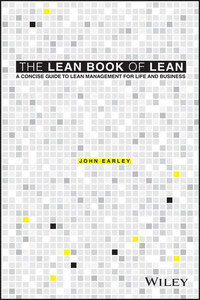This edition first published 2016
© 2016 John Earley
Registered office
John Wiley & Sons Ltd, The Atrium, Southern Gate, Chichester, West Sussex, PO19
8SQ, United Kingdom
For details of our global editorial offices, for customer services and for information about how to apply for permission to reuse the copyright material in this book please visit our website at www.wiley.com.
The right of the author to be identified as the author of this work has been asserted in accordance with the Copyright, Designs and Patents Act 1988.
All rights reserved. No part of this publication may be reproduced, stored in a retrieval system, or transmitted, in any form or by any means, electronic, mechanical, photocopying, recording or otherwise, except as permitted by the UK Copyright, Designs and Patents Act 1988, without the prior permission of the publisher.
Wiley publishes in a variety of print and electronic formats and by print-on-demand. Some material included with standard print versions of this book may not be included in e-books or in print-on-demand. If this book refers to media such as a CD or DVD that is not included in the version you purchased, you may download this material at http://booksupport.wiley.com. For more information about Wiley products, visit www.wiley.com.
Designations used by companies to distinguish their products are often claimed as trademarks. All brand names and product names used in this book are trade names, service marks, trademarks or registered trademarks of their respective owners. The publisher is not associated with any product or vendor mentioned in this book.
Limit of Liability/Disclaimer of Warranty: While the publisher and author have used their best efforts in preparing this book, they make no representations or warranties with respect to the accuracy or completeness of the contents of this book and specifically disclaim any implied warranties of merchantability or fitness for a particular purpose. It is sold on the understanding that the publisher is not engaged in rendering professional services and neither the publisher nor the author shall be liable for damages arising herefrom. If professional advice or other expert assistance is required, the services of a competent professional should be sought.
Library of Congress Cataloging-in-Publication Data is available
A catalogue record for this book is available from the British Library.
ISBN 978-1-119-09619-1 (pbk) ISBN 978-1-119-09620-7 (ebk)
ISBN 978-1-119-09621-4 (ebk) ISBN 978-1-119-27170-3 (ebk)
Cover Design: Kathy Davis/Wiley
Cover Image: © singpentinkhappy/Shutterstock
Without the help, support and inspiration from those around me throughout my life, this book would never have been written and my life would have been very different. While there are many who have guided, prodded and cajoled me into what I am, there are a few people to whom I would like to specifically say a big “thank you” in the context of this book.
Firstly, my wife Helen, who has supported and put up with me for over 30 years and kept believing in me, even when things haven't gone quite according to plan.
To Jim Prendergast, a Partner with PricewaterhouseCoopers, who recognised the Lean in me and let me loose to practise and develop my skills. His mentorship helped me to turn some good concepts and rough thoughts into practical approaches to helping people see the light. To the others in the “Lean Team” at PwC who were instrumental in a lot of the thinking behind this book.
To James C. Paterson, author of Lean Auditing and a colleague from my time at AstraZeneca. James very kindly introduced me to his contact at Wiley which opened the door to turning a pipe dream into reality. To Gemma from Wiley who sponsored this book and has been very patient with me during the writing and publishing process.
Thank you all for your help, support and encouragement.
Why did I choose to call this book The Lean Book of Lean? Having attempted to read many of the books published on the subject, I always found myself unable to finish them. That's not to say that they are irrelevant, badly written or uninteresting, it is just that with the little time available to your average busy person, there is always something which takes priority. I often questioned, why doesn't someone write a book which covers the major points, has some useful hints and tips, but can be read during your average 3 to 4 hour flight? (And have time for your in-flight drink as well!) After many years pondering this issue, I came to the conclusion that the “someone” might as well be me.
As more of an afterthought, but just as relevant, Lean is all about achieving a desired outcome with the minimal amount of fuss and effort, so I felt compelled to write a book which practises what it preaches.
In addition, I have become increasingly frustrated over the years with learned people and scholars trying to make out that Lean is magic, something only they can easily understand. I'm on slightly shaky ground here as I'm a consultant myself and have made a more than decent living from helping others “get it” so could be considered as one of the culprits mentioned above. To try and break this myth, I've tried to explain the concepts and principles in everyday terms and demonstrate that we all “do Lean” naturally in our everyday lives. In a light-hearted vein, I've also added a glossary in the back defining some of the key Lean terms in the same way.








